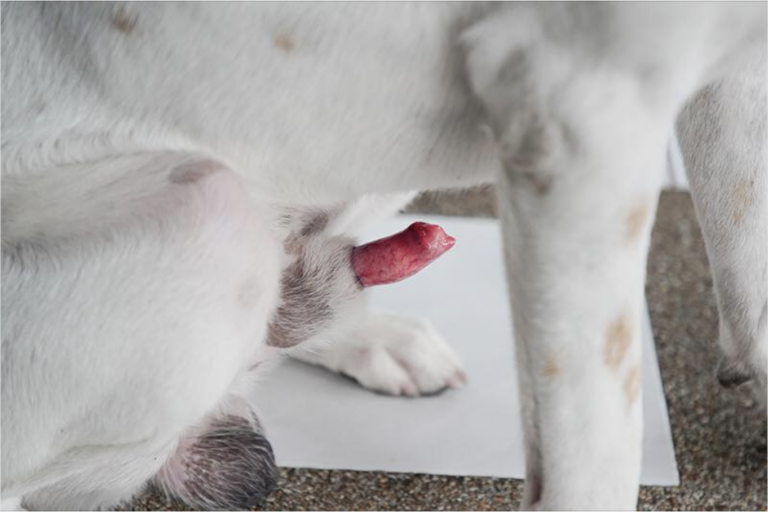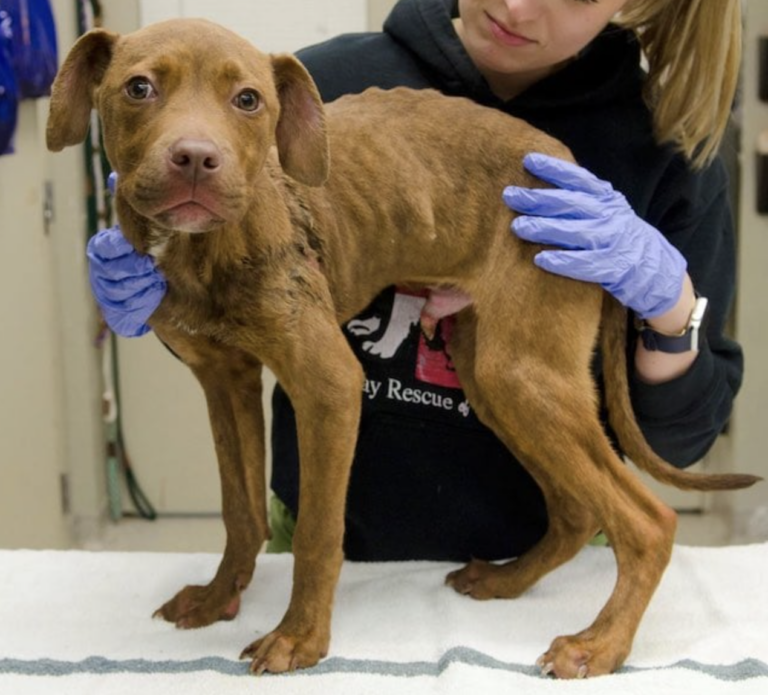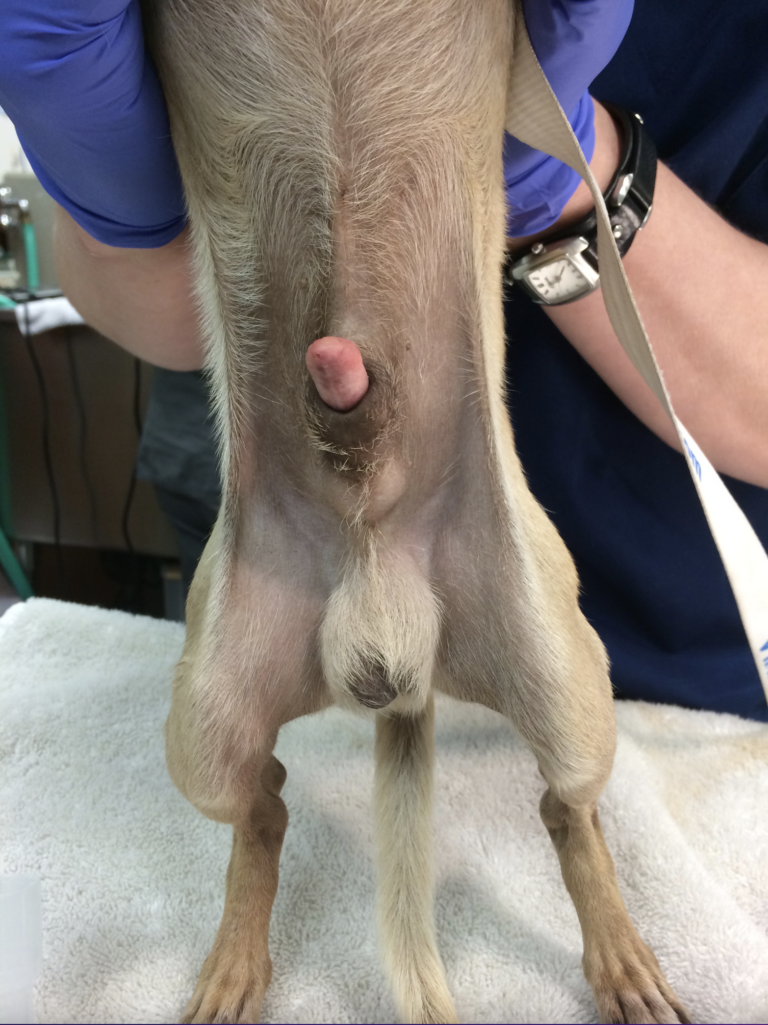Learn About Paraphimosis in Dogs—An Embarrassing & Potentially Dangerous Condition
Content Warning: This blog discusses and shows pictures of paraphimosis in dogs and describes canine reproductive anatomy.

“I was dog-sitting a Toy Poodle—I walked into the room and noticed he was hunched over looking scared and didn’t want to move,” said Lorna L., a dog expert we spoke with who experienced a near-emergency with a dog in her care. “He is only 1, so he’s always moving and high-energy, so I was concerned. Upon closer inspection, I saw his “lipstick” was out.”

Pause—if you own male dogs, you know whether they’re neutered or not, their “lipstick” or “red rocket” will poke out on occasion. Usually, this isn’t an issue and will disappear in a few seconds, but what would you do if you could tell your dog’s penis was causing them discomfort or even pain?
“This little dog wouldn’t move, and I was worried I was going to have to intervene somehow because if a dog’s penis is still out after 20–30 minutes it becomes dangerous,” Lorna continued in our interview. “I’m very glad I didn’t have to get involved, but I think more people should know about the risks associated with paraphimosis and what to do to prevent an emergency.”
What is Paraphimosis in Dogs?
The condition called paraphimosis occurs when a dog cannot retract or reduce its penis back into the sheath or “prepuce.” In basic terms, paraphimosis is a doggy erection that won’t go down.
Signs & Symptoms of Paraphimosis in Dogs

It’s normal for a dog’s glans penis to protrude occasionally for a few minutes, but paraphimosis becomes a concern if it remains unsheathed for upwards of 20–30 minutes. Other signs of paraphimosis and signs that your dog is suffering from a pet emergency include:
- Discoloration, irritation, and visible dryness of the exposed penis
- Swelling of the penis
- Inability to urinate
- Signs of distress or discomfort from your dog (e.g. excessive licking, hunching, refusing to move)
All these symptoms are indicators of an emergency, and you should contact your veterinarian immediately. It is not safe to address the situation yourself once a dog is experiencing a case of paraphimosis, and without immediate intervention, your dog may require emergency surgery.
Causes of Dog Paraphimosis

Any male dog can develop paraphimosis, but the condition is more common among unneutered males. Dogs may develop paraphimosis for a variety of reasons, but the most common reason is having a small preputial opening. This congenital condition isn’t something that can be prevented, and your dog simply has a smaller “sheath” opening than is necessary for their glans to comfortably retract.
While congenital paraphimosis is more common, acquired paraphimosis can also affect male dogs of all ages. Some common triggers for acquired paraphimosis include:
- Foreign bodies wrapped around the glans or base of the penis (e.g. a piece of hair or dental floss)
- Dirt, grime, or debris collected on the glans
- Swelling following mating or ejaculation
- Trauma to the penis (e.g. chemical irritation or physical injury)
- Certain cancers
Treatment Options for Paraphimosis in Dogs

An inability to retract the penis can be extremely dangerous, and it’s important to take action the moment you notice something unusual. There are options for preventing and treating very low-grade paraphimosis in dogs at home, but the vast majority of paraphimosis cases require treatment from a veterinarian.
How To Fix Paraphimosis in Dogs at Home
If you notice that your dog’s penis has been out for an unusual amount of time and are concerned that it could turn into paraphimosis, or you notice a small amount of swelling at the base of the penis (above the sheath) it is safe to intervene to prevent the issue from advancing to paraphimosis and an emergency. Only a veterinarian should treat a dog with paraphimosis.
For instructions on how to prevent or temporarily provide relief to a dog with paraphimosis, read this guide by Dr. Brad Hinsperger, DVM with complete instructions.
Veterinary Intervention
If your dog does not immediately respond to your preventive treatment, you should contact your veterinarian. With immediate treatment for paraphimosis dogs typically make a full recovery. If treatment is delayed or the condition has become too advanced, the penis can begin to lose blood flow and partial or total amputation may be necessary.

Typically, veterinary intervention for dogs with paraphimosis includes:
- Cleaning and removal of foreign objects
- Applications of lubricant and antiseptic
- Antibiotic and corticosteroid treatments to reduce the swelling
- Surgical management
- Amputation (in extreme cases)
Preventing Paraphimosis in Dogs
You can’t do much about congenital issues or underlying health problems like cancer at home, but Dr. Teri Ann Oursler, DVM has some advice for preventing acquired paraphimosis for other reasons. “Keep your dog’s penis clean just by splashing water over it, and clean it after every mating attempt…If your dog has a long or curly coat, clip the area neatly at the base to prevent matting or knotting.”
If you are not breeding your dog—which most pet owners are not, thankfully—you can also gently redirect your dog from humping toys, other dogs, or inanimate objects to avoid the risk of paraphimosis. Neutering your dog can help to reduce some of the heightened states that can precede paraphimosis.
If your dog has experienced issues retracting its glans penis, it is worth discussing preventive treatments with a doctor. If your dog is determined to have congenital paraphimosis, your vet may recommend a preventive surgery to widen the opening of the sheath, making it easier for your dog to retract its penis.
Related Articles:
- Warning Signals: Identifying Dehydration in Dogs Before It’s Too Late
- How To Detect, Treat, and Prevent Fly Strike in Dogs
- Hydrocephalus in Dogs




